Journal of
eISSN: 2473-0831


Research Article Volume 6 Issue 1
Correspondence: Abdalla Ahmed Elbashir, Department of Chemistry, Faculty of science, University of Khartoum, Sudan
Received: August 01, 2017 | Published: August 29, 2017
Citation: Osman RAM, Elbashir AA (2017) A High-Performance Liquid Chromatographic (HPLC) Method for the Determination of Amlodipine Drug in Dosage form Using 1,2-Naphthoquine-4-Sulfonate (NQS). J Anal Pharm Res 6(1): 00163. DOI: 10.15406/japlr.2017.06.00163
A rapid, simple and sensitive high-performance liquid chromatographic (HPLC) method for determination of Amlodipine (AML) using sodium 1,2-naphthoquinone-4-sulfonate (NQS) has been developed. The method is based on the formation of a brown color product from the reaction between AML and NQS. The nucleophilic substitution reaction proceeds quantitatively at pH 13 buffer solution with absorption maximum at 465 nm. A C18 column ODS (250mm×4.6mm), 5μm and a mobile phase of combination is potassium dihydrogen orthophosphate (0.05M) in water: acetonitrile (45:55%v/v) were used for separation and quantification. Analyses were run at a flow-rate of 1.5mL/min and at 40 °C temperature. The injection volume was 20μL and the photodiode array detector was set at 465nm. Under these conditions Amlodipine-NQS eluted at 3.12 min. Total run time was shorter than 5 min. The developed method was validated according to the literature and found to be linear within the range 2-30μg /mL, describes by the regression equation y =207,082x +1,481.71 with a regression coefficient 0.999. The limit of detection and quantity are 0.01μg/mL and 0.04μg∕ mL respectively. This method is simple and can be applied for the determination of AML in pharmaceutical formulation in quality control laboratories.
Keywords: Amlodipine besylate; High performance liquid chromatography; Method development; Sodium 1,2-naphthoquine-4sulfonate
HPLC, high-performance liquid chromatographic; AML, amlodipine; NQS, 1,2-naphthoquinone-4-sulfonate; TLC, thin layer chromatography; LC-MS, liquid chromatography mass spectrometry
Amlodipine Besylate (AML), chemically is 3-ethyl 5-methyl (4RS)-2-[(2-aminoethoxy) methyl]-4-(2chlorophenyl)-6-methyl-1,4-dihydropyridine-3,5-dicarboxylate benzene sulphonate (Figure 1). It belongs to the class of calcium channel blocker, AML is a long-acting calcium channel blocker (dihydropyridine derivative) used as an anti-hypertensive and in the treatment of angina.1
Literature review showed different analytical methods for the analysis of amlodipine in pharmaceutical preparations or biological fluids either as a single drug or in combination with other drugs. Those analytical methods include: spectrophotometric methods with or without derivatization.2-7 The derivative spectroscopy has also been applied for the determination of amlodipine and its photodegradant compound.8 Chromatographic methods have been used widely for the analysis of AML, including thin layer chromatography (TLC) methods9-12 and HPLC methods.13,14 Capillary electrophoresis methods were also used for the analysis of AML in its formulations and biological fluids.15,16 AML was also determined using liquid chromatography mass spectrometry (LC-MS).17,18
1, 2-naphthoquinone-4-sulphonate (NQS) has been used as a chromogenic reagent for the colorimetric determination of many pharmaceutical amines.19-21 The applications of NQS for determination of pharmaceutical bearing amine group have been reviewed by Elbashir et al.22-27 However, the reaction of NQS with AML has to the best of our knowledge, not been investigated. Therefore the present study is devoted to investigate the optimum reaction conditions of NQS with AML using spectrophotometry and application for the development of a simple and rapid HPLC method for the determination of AML in pharmaceutical dosage forms.
Materials
Amlodipine Besylate working standards was donated from Azal pharmaceutical industries company Ltd, (Khartoum, Sudan). Acetonitrile HPLC grade, Methanol HPLC grade, Potassium dihydrogen orthophosphate AR and sodium hydroxide were purchased from scharlau chemical (spain). High purity deionised water was obtained from Azal pharmaceutical (Khartoum, Sudan) purification system. Sodium 1, 2-naphthoquinone-4sulphonate (NQS) (Sigma Aldrich Chemical Co, St. Louis, USA)
Methods
Instrumentation: Chromatographic separation was performed with Shimadzu high performance liquid chromatography having C18, ODS (250mm×4.6mm), 5μm analytical column with photodiode array detector provided by Auto sampler and the Chromatographic data were recorded by LC Solution software. Absorbance was carried out by using UV-visible spectrophotometer model Shimadzu 1800 with quartz cells of 1cm optical path length, pH meter was used for pH measurements, analytical balance and ultrasonic bath.
Chromatographic conditions: For HPLC a number of preliminary trials were conducted with combinations of different organic solvents, compositions, and flow rate to check the retention time, shape, resolution, and other chromatographic parameters. Among all tried experiments, the mobile phase combination of potassium dihydrogen orthophosphate (0.05M) in water: acetonitrile (45:55%v/v) was found to be more suitable. The solution was degassed in an ultrasonic water bath for 5 minutes and filtered through 0.45μm nylon filter. The instrumental settings flow rate of 1.5mL/min; the column temperature is 40°C, and detector wavelength is 465nm found to be most suitable. Best resolution and sensitivity of the method were obtained for NQS and AML. Typical chromatogram with optimized condition gives sharp and symmetric peak with retention time of 3.132 min.
Preparation of standard and sample solutions
Standard solution of AML (200μg/mL)
standard solution of AML (200µg/ml): An accurately 20mg of AML standard was dissolved in a mixture of equal volume of methanol and distilled water, transferred into 100mL volumetric flask, diluted to the mark with same solvent and mixed well.
Sodium 1, 2-naphthoquinone-4-sulfonic solution (0.5% w/v): (NQS) 0.5% (w/v) was prepared by dissolving 0.5g in mixture of equal volume of methanol and distilled water, transferred into a 100mL volumetric flask and diluted to the mark with same solvent and mixed well. The solution was freshly prepared and protected from light during use.
Buffer solutions: Buffer solution of pH 13.0 was prepared by mix solution of 0.2M potassium dihydrogen phosphate and 0.2M sodium hydroxide adjusted to pH 13.0 with 0.2M sodium hydroxide.
Sample Solutions
Sample solution: Preparation of Amlodipine tablets by an accurately weighed 700mg of amlodipine tablet equivalent to 20mg of Amlodipine, dissolved by sonication in a mixture of equal volume of methanol and distilled water into a 100mL volumetric flask, diluted to the mark with the same solvent (200µg/mL).
General recommended procedure
A 1.0mL of 200μg/mL of Amlodipine was transferred into 10mL volumetric flask; 1.5mL of 0.5% (NQS) was added and followed by 1.5mL buffer solution pH 13.0. The reaction was completed to volume with mixture of equal volume of methanol and distilled water, After 5 min, a suitable volume of solution was sampled and filtered through 0.45μm membrane filter paper. The solution was determined by HPLC conditions developed herein.
Determination of the stoichiometric ratio of the reaction (Job’s method)
The Job’s method (Oliner & Boyd 1964) of continuous variation was employed. Equimolar (5x10-3 M) aqueous solutions of AML and NQS were prepared. A series of 10mL portions of stock solutions of AML and NQS were made up comprising different complementary proportions (0:10, 1:9, 2:8, 3:7, 4:6, 5:5, 6:4, 7:3, 8:2, 9:1, 10:0). The solution was further treated as described under the general recommended procedure.
Absorption spectra
The absorption spectrum of AML was recorded against mixture of methanol and water (50:50) (Figure 2); it was found that AML exhibits a maximum absorption peak (λmax) at 238nm. Because of highly orange shifted λmax of AML, its determination in the dosage form based on the direct measurement of its absorption for ultraviolet is susceptible to potential interferences from the common excipients. Therefore, derivatization of AML red–shifted light-absorbing derivative was necessary. The reaction between AML and NQS was performed, and the absorption spectrum of the product was recorded against reagent blank (Figure 2). It was found that the product is brown colored exhibiting λmax at 465nm, and the λmax of NQS was 361 nm. The λmax of AML-NQS derivative was red-shifted, eliminating any potential interference. Therefore, the measurements were carried out at 465nm.
Stoichiometry of derivatization reaction
Under the optimum conditions the stoichiometry of the reaction between AML with NQS was investigated by Job’s method and was found to be 1:1, While AML molecule contain primary and secondary amino group. Based on this ratio, the reaction pathway was postulated to be proceeded as shown in Scheme 1.
Optimization of derivatization reaction and spectrophotometric procedure
Effect of pH: The effect of pH on the reaction of AML with NQS was investigated. By varying the pH from 6.0 to 13.5, the influence of pH on the absorbance of AML-NQS product is shown in Figure 3. The results revealed that the absorbance’s at pH less than 6-8 were close to 0, indicating that underthis pH range, AML has difficulty to react with NQS. At pH more than8.0, the absorbance increased rapidly with the increase in the pH, as the amino group of AML turns into the free-NH, facilitating the nucleophilic substitution reaction. The maximum absorption values were attained in the range of pH at 13.0. At pH more than 13.5 the absorbance of solution obviously decreased. This was attributed probably to the increase in the amount of hydroxide ion that holds back the condensation reaction between AML and NQS. In order to keep the high sensibility for determination of amlodipine, the experiment was carried out at pH 13.0.
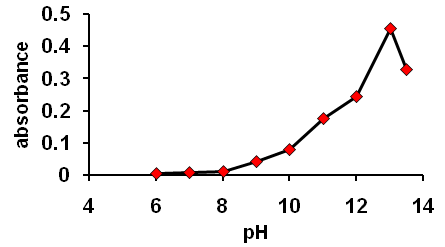
Figure 3 Effect of pH on absorbance of product AML with NQS, AML (200µg/mL): 1.0mL; buffer solution: 1.0mL; NQS (0.5%, w/v): 1.0mL; at room temperature; reaction time: 5min.
Effect of (NQS) concentration: The studying of NQS concentrations revealed that the reaction was dependent on NQS reagent. The absorbance of the reaction solution increased as the NQS concentration increased, and the highest absorption intensity was attained at NQS concentration of 0.5 % (w/v) Figure 4 Higher NQS concentrations up to 0.8 % had no effect on the absorption values. Further experiments were carried out using 0.5% (w/v).
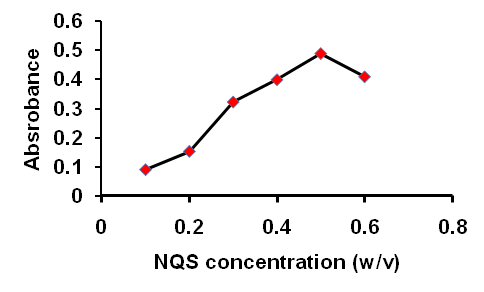
Figure 4 Effect of NQS concentrations on the reaction of AMLwith NQS. AML (200µg/mL):1.0mL; NQS: 1.0mL; buffer solution (pH 13): 1.0mL; at room temperature; reaction time: 5 min.
Effect of reaction time: Keeping the experimental conditions unchanged, the absorbance of the solution of AML-NQS complex was measured after standing for various time periods, Figure 5. The results show that AML reacts immediately with NQS at room temperature; 5min is selected as the optimum condition.
Effect of amount of the buffer: Keeping pH at 13.0, the effect of amount of buffer solution on the absorbance of reaction product was also studied. It shows that the absorbance of the reaction product enhances rapidly with the rise of amount of buffer solution, and becomes maximal when the amount of buffer solution is 1.5mL. Therefore, the amount of 1.5mL buffer solution was selected to ensure the highest absorbance.
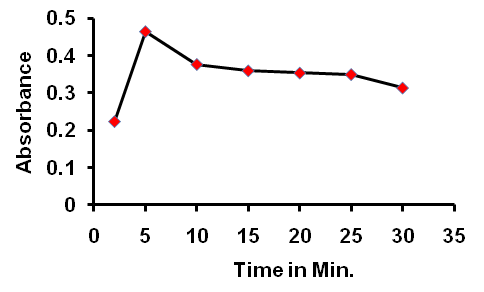
Figure 5 Effect of standing time on the reaction of AMLwith NQS. AML (200µg/mL): 1.0mL; buffer solution (pH 13):1.0mL; NQS (0.5%, w/v): 1.0mL; at room temperature.
Validation of the methods
Methods Validation: Establishing documented evidence that provides a high degree of assurance that a specific method, and the ancillary instruments included in the method, will consistently yield results that accurately reflect the quality characteristics of the product tested. The most widely applied typical validation characteristics for various types of tests are accuracy, precision (repeatability and intermediate precision), specificity, detection limit, quantitation limit, linearity, range, and robustness.
Specificity
The specificity of the assay method was investigated by the injection of the extracted placebo and mobile phase to demonstrate the absence of interference with the elution of analyte. The injected of placebo and mobile phase found that no of interference between AML, NQS and mobile phase (Figure 6 & 7). Also the injection of AML and NQS have shown no interference and the method should be selective (Figure 8 & 9).
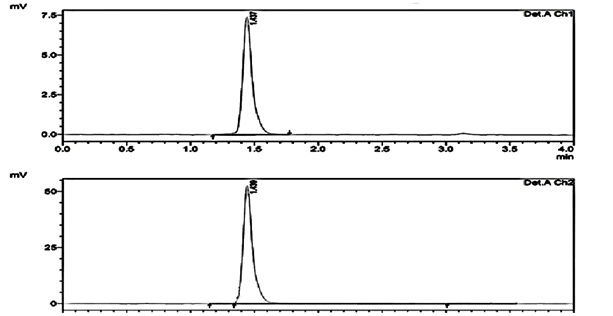
Figure 8 Chromatographic peak of NQS in Ch1 (465 nm) and Ch2 (271) show the peak in same retention time.
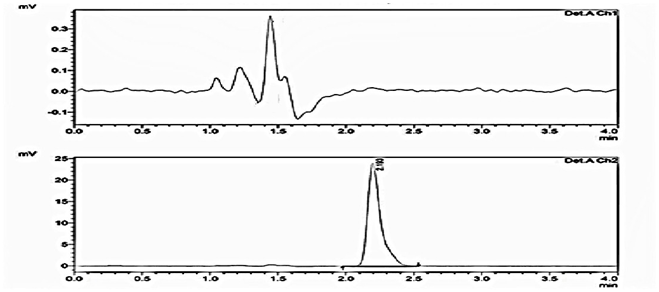
Figure 9 Chromatographic peak of amlodipine Besylate in Ch1 (465nm) no peak due to amlodipine and Ch2 (271) the Amlodipine eluted.
Linearity
The linearity was evaluated by linear regression analysis determined by its reaction with NQS was constructed by plotting area as a function of the corresponding concentration, in the range of 2-30µg/ mL, which was calculated by the least square regression method to calculate the calibration equation and the correlation coefficient. The calibration curves were constructed by plotting concentration versus peak area Figure 10, using linear regression analysis. The regression equation for the results was y =207,082x + 1,481.71 (r2=0.999), where y is the area at 465nm, x is the concentration of amlodipine in µg/ml in the range of 2-30µg/mL, and r is correlation coefficient (Table 1). The limit of detection (LOD) and limit of quantification (LOQ) were determined according to the following formula LOD=3.3×SDa/b, and LOQ=10×SDa/b, SDa is the standard deviation of the blank, b is the slope under the ICH guidelines. The LOD and LOQ were found to be 0.01 and 0.04µg/mL, respectively Table 1.
|
Parameter |
Value |
|
Measurement wavelength (nm) |
465nm |
|
Linear range (μg/mL) |
2-30μg/mL |
|
Standard deviation of the Blank Slope |
1035 |
|
Intercept |
1481.714286 |
|
Slope |
207081.964286 |
|
Correlation coefficient (r) |
0.999 |
|
Limit of detection, LOD (μg/mL) |
0.02 |
|
Limit of quant., LOQ (μg/mL) |
0.05 |
Table 1 Parameters for the performance of the proposed method
Accuracy
Accuracy expresses the closeness of agreement between the conventional true value or an accepted reference value and the value found. The accuracy of the proposed method was carried out by applying 3 different concentrations 16, 20, and 24μg/mL of AML drug within linear range calculated as the percentage of the drug recovered from the samples, Table 2.
|
Sample No |
Sample Content (μg/ mL) |
Amount Amlodipine |
Amount Found |
Recovery |
|
1 |
16 |
16 |
15.98 |
99.875 |
|
2 |
20 |
20 |
19.89 |
99.45 |
|
3 |
24 |
24 |
23.86 |
99.41667 |
Table 2 Recovery studies for the determination of amlodipine, by the proposed
Robustness
The robustness is defined as a measure of its capacity to remain unaffected by small but deliberate variations in experimental parameters, providing an indication of the analytical method’s suitability and reliability during normal use. In these experiments, one parameter was changed whereas the others were kept unchanged, and the retention time of peak was recorded each time. It was found that small variation in the method variables did not significantly affect the procedures, Table 3.
|
Change in |
Before Change |
Flow Rate |
Flow Rate |
Mobile Phase |
Mobile Phase |
λnm |
λnm |
|
Parameter |
1.4ml/min |
1.6 mL/min |
+10% Acetonitrile |
-10 % Acetonitrile |
- 5nm |
+ 5nm |
|
|
Retention Time 1 |
3.13 |
3.347 |
3.002 |
2.888 |
3.675 |
3.12 |
3.13 |
|
Retention Time 2 |
3.11 |
3.348 |
3.011 |
2.886 |
3.678 |
3.12 |
3.13 |
|
Retention Time 3 |
3.12 |
3.346 |
3.012 |
2.889 |
3.677 |
3.13 |
3.13 |
|
Avg for Retention Time |
3.12 |
3.347 |
3.008 |
2.888 |
3.677 |
3.12 |
3.13 |
|
RSD% |
0.321 |
0.030 |
0.183 |
0.053 |
0.042 |
0.067 |
0.49 |
|
Tailing Factor 1 |
1.231 |
1.222 |
1.239 |
1.181 |
1.269 |
1.23 |
1.22 |
|
Tailing Factor 2 |
1.242 |
1.225 |
1.241 |
1.183 |
1.27 |
1.22 |
1.23 |
|
Tailing Factor 3 |
1.241 |
1.227 |
1.243 |
1.183 |
1.265 |
1.22 |
1.21 |
|
Avg for Tailing Factor |
1.238 |
1.22467 |
1.241 |
1.18233 |
1.268 |
1.22 |
1.22 |
|
RSD% |
0.491 |
0.205 |
0.161 |
0.098 |
0.209 |
0.125 |
0.592 |
Table 3 Influence of small variation in the assay condition on the analytical performance of the proposed HPLC method for determination of AML using NQS reagent
Application of the proposed method to analysis of AML dosage form
AML tablets were subjected to the analysis by the proposed as well as with the official HPLC method (United States pharmacopeia) and the obtained results were statistically compared with each other. The label claim percentage was 99.63 and 99.75 for amlozal batch No 6206 (Table 4). This indicated similar accuracy and precision in the analysis of AML in tablets. The proposed method has the advantage of being virtually free from interferences by excipients as shown in Figure 11.
|
Dosage form |
Recovery % +RSD |
Agreement Between Two Methods |
|
|
Official Method |
Proposed Method |
||
|
Amlozal batch # 6206 |
99.8 |
99.6 |
100.2 |
|
Amlozal batch # 6206 |
99.45 |
99.7 |
99.55 |
|
Average % |
99.63 |
99.75 |
99.9 |
Table 4 Analysis of Amlodipine containing dosage forms by the proposed and Official HPLC methods (United States Pharmacopoeia)
Reaction mechanism
Derivatization of AML was attempted in the present study for the development of HPLC method for its determination. The present method is based on the reaction between the NQS and AML molecules. The NQS reagent reacts with AML at the free NH group. The reagent blank has negligible absorbance in the range used for detection of the AML. Similarly, amino group of AML, taking on nucleophilicity due lone electron pair of nitrogen atom, trend to attack on the electron–deficient center in NQS, namely no.4 carbon atom (3,4-C=C carbon bond conjugate with 2-C=O, as a result 4-C of NQS becomes electron lacking center). At the same time, it has been proved that the composition of product I is 1:1 of AML and NQS (Figure 12). So it is concluded that amino group of AML react with 4-sodium sulphonate of NQS molecule respectively, to form brown N-alkyl-amino naphthoquinone. The reaction equation is shown in Scheme 1.
The present paper described the evaluation of NQS as analytical reagents in the development of simple, sensitive, and accurate HPLC methods, for the determination of AML in pharmaceutical formulation. The proposed method is simple, reliable, specific, accurate, reproducible, and highly sensitive, for the determination of AML in commercially available dosage forms. The procedure presented here does not need necessitate any expensive apparatus; therefore the proposed method can be used advantageously as a routine method for the determination of AML in quality control and industry, our method may be applied to the determination of other secondary amine derivatives as well.

©2017 Osman, et al. This is an open access article distributed under the terms of the, which permits unrestricted use, distribution, and build upon your work non-commercially.